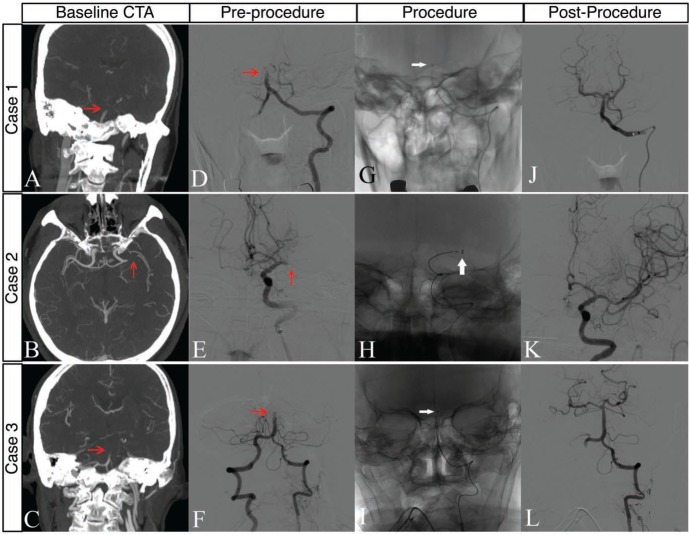Neurointervention.
2017 Mar;12(1):45-49. 10.5469/neuroint.2017.12.1.45.
Forced Arterial Suction Thrombectomy Using Distal Access Catheter in Acute Ischemic Stroke
- Affiliations
-
- 1Department of Neurology, Kyungpook National University Hospital, School of Medicine, Kyungpook National University, Daegu, Korea. yw.kim23@gmail.com
- 2Department of Neurosurgery, Kyungpook National University Hospital, School of Medicine, Kyungpook National University, Daegu, Korea.
- 3Department of Radiology, Kyungpook National University Hospital, School of Medicine, Kyungpook National University, Daegu, Korea.
- KMID: 2371758
- DOI: http://doi.org/10.5469/neuroint.2017.12.1.45
Abstract
- Historical innovations in mechanical thrombectomy devices and strategies for ischemic stroke have resulted in improved angiographic outcomes and better clinical outcomes. Various devices have been used, but the two most common approaches are aspiration thrombectomy and stent-retrieval thrombectomy. Aspiration thrombectomy has advanced from the traditional Penumbra system to forced arterial suction thrombectomy and a direct aspiration first-pass technique. Newer generation aspiration catheters with flexible distal tips and a larger bore have demonstrated faster and better recanalization relative to older devices. Recently, several species of distal access catheters have similar structural characteristics to the Penumbra reperfusion catheter. Therefore, we used the distal access catheter for forced arterial suction thrombectomy in three patients with acute ischemic stroke. In each case, we achieved fast and complete recanalization without significant complications. Forced arterial suction thrombectomy using a distal access catheter might provide another option for mechanical thrombectomy in patients with acute ischemic stroke.
Keyword
Figure
Cited by 2 articles
-
Optimal Guiding Catheter Length for Endovascular Coiling of Intracranial Aneurysms in Anterior Circulation in Era of Flourishing Distal Access System
Zhen Yu Jia, Sang Hun Lee, Young Eun Kim, Joon Ho Choi, Sun Moon Hwang, Ga Young Lee, Jin Ho Youn, Deok Hee Lee
Neurointervention. 2017;12(2):91-99. doi: 10.5469/neuroint.2017.12.2.91.Forced suction thrombectomy in patients with acute ischemic stroke using the SOFIA Plus device
Hyun Ki Roh, Min-Wook Ju, Hyoung Soo Byoun, Bumsoo Park, Kwang Hyon Park, Jeongwook Lim
J Cerebrovasc Endovasc Neurosurg. 2022;24(3):241-248. doi: 10.7461/jcen.2022.E2021.12.002.
Reference
-
1. Spiotta AM, Chaudry MI, Hui FK, Turner RD, Kellogg RT, Turk AS. Evolution of thrombectomy approaches and devices for acute stroke: a technical review. J Neurointerv Surg. 2015; 7:2–7. PMID: 24385554.
Article2. Berkhemer OA, Fransen PS, Beumer D, van den Berg LA, Lingsma HF, Yoo AJ, et al. A randomized trial of intraarterial treatment for acute ischemic stroke. N Engl J Med. 2015; 372:11–20. PMID: 25517348.3. Goyal M, Demchuk AM, Menon BK, Eesa M, Rempel JL, Thornton J, et al. Randomized assessment of rapid endovascular treatment of ischemic stroke. N Engl J Med. 2015; 372:1019–1030. PMID: 25671798.4. Campbell BC, Mitchell PJ, Kleinig TJ, Dewey HM, Churilov L, Yassi N, et al. Endovascular therapy for ischemic stroke with perfusion-imaging selection. N Engl J Med. 2015; 372:1009–1018. PMID: 25671797.
Article5. Jovin TG, Chamorro A, Cobo E, de Miquel MA, Molina CA, Rovira A, et al. Thrombectomy within 8 hours after symptom onset in ischemic stroke. N Engl J Med. 2015; 372:2296–2306. PMID: 25882510.
Article6. Saver JL, Goyal M, Bonafe A, Diener HC, Levy EI, Pereira VM, et al. Stent-retriever thrombectomy after intravenous t-PA vs. t-PA alone in stroke. N Engl J Med. 2015; 372:2285–2229. PMID: 25882376.
Article7. Powers WJ, Derdeyn CP, Biller J, Coffey CS, Hoh BL, Jauch EC, et al. 2015 American Heart Association/American Stroke Association Focused Update of the 2013 Guidelines for the Early Management of Patients With Acute Ischemic Stroke Regarding Endovascular Treatment: A Guideline for Healthcare Professionals From the American Heart Association/American Stroke Association. Stroke. 2015; 46:3020–3035. PMID: 26123479.
Article8. Turk AS, Frei D, Fiorella D, Mocco J, Baxter B, Siddiqui A, et al. ADAPT FAST study: a direct aspiration first pass technique for acute stroke thrombectomy. J Neurointerv Surg. 2014; 6:260–264. PMID: 24569575.
Article9. Teng D, Pannell JS, Rennert RC, Li J, Li YS, Wong VW, et al. Endothelial trauma from mechanical thrombectomy in acute stroke. Stroke. 2015; 46:1099–1106. PMID: 25712942.
Article10. Hu YC, Stiefel MF. Force and aspiration analysis of the ADAPT technique in acute ischemic stroke treatment. J Neurointerv Surg. 2016; 8:244–246. PMID: 25618896.
Article11. Son S, Choi DS, Oh MK, Hong J, Kim SK, Kang H, et al. Comparison of Solitaire thrombectomy and Penumbra suction thrombectomy in patients with acute ischemic stroke caused by basilar artery occlusion. J Neurointerv Surg. 2016; 8:13–18. PMID: 25411420.
Article12. Kabbasch C, Möhlenbruch M, Stampfl S, Mpotsaris A, Behme D, Liebig T. First-line lesional aspiration in acute stroke thrombectomy using a novel intermediate catheter: initial experiences with the SOFIA. Interv Neuroradiol. 2016; 22:333–339. PMID: 26908589.
Article13. Penumbra Pivotal Stroke Trial Investigators. The penumbra pivotal stroke trial: safety and effectiveness of a new generation of mechanical devices for clot removal in intracranial large vessel occlusive disease. Stroke. 2009; 40:2761–2768. PMID: 19590057.
- Full Text Links
- Actions
-
Cited
- CITED
-
- Close
- Share
- Similar articles
-
- Suction thrombectomy of distal medium vessel occlusion using microcatheter during mechanical thrombectomy for acute ischemic stroke: A case series
- Forced suction thrombectomy in patients with acute ischemic stroke using the SOFIA Plus device
- Forced Arterial Suction Thrombectomy of Septic Embolic Middle Cerebral Artery Occlusion Due to Infective Endocarditis: an Illustrative Case and Review of the Literature
- Pseudoaneurysm Formation after Repetitive Suction Thrombectomy Using a Penumbra Suction Catheter
- Directly Retrieved Entire Clot from Forced Suction Thrombectomy Using the Penumbra System in Acute Middle Cerebral Artery Occlusion


